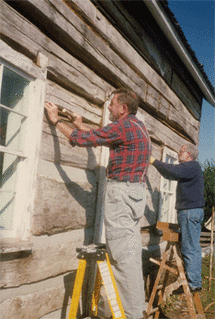Historyof the Arboretum

-
1972: The idea for an arboretum was initiated when President Barth asked Charles Mason, professor of Biology and future arboretum director, for trees around the president's house. The first trees of the Arboretum were planted by volunteers in 1973.

1975: A master plan was developed for the Arboretum, with 3 natural ecosystems and a formal gardens area. Charles Mason was appointed Director of the Arboretum.
1986: The Borgeson Cabin was moved from Norseland, MN to the Arboretum. The Borgeson Cabin was home to a Swedish immigrant family and is a wonderful example of traditional construction.
1987: The Melva Lind Interpretive Center was completed to house the Arboretum staff, Environmental Studies, interpretive educational exhibits, and a meeting space, which is available for private events.

1988: Restoration of the Uhler Prairie began with the help of many students and community members. Gustavus Adolphus College Arboretum was named the Linnaeus Arboretum in honor of Carl Linnaeus (1707-1778), a Swedish botanist famous for devising the binomial nomenclature system we use today to name organisms.
1989: Friends of the Linnaeus Arboretum (FLA) was established. This group supports the Arboretum through volunteer activities. Educational programs are offered throughout the year for FLA members.
1998: A tornado devastated the campus, causing significant damage to the Arboretum. On campus, the tornado broke 80 percent of the windows, leveled nearly 2,000 trees, toppled the chapel's spire, destroyed Johnson Hall, and caused more than $50 million in damages. In the fall, Jim Gilbert joined the Linnaeus Arboretum as Executive Director and Instructor of Environmental Studies.
1999: Construction of the Loreli Olson Steuer Wetland Preserve began.
2003: The 30-year anniversary of Linnaeus Arboretum was celebrated by holding the first Linnaeus Symposium, featuring well-renowned ethnobotanist, Wade Davis.
2005: The Jim Gilbert Teaching Pond was dedicated following his retirement as the Executive Director of the Arboretum. Jim's dedication to educating young people about the natural world is his hallmark and heralded in this teaching facility.
2006: Dr. Cindy Johnson was appointed as the Executive Director of Linnaeus Arboretum.
2007: The second biennial Linnaeus Symposium was held on the 300th anniversary of the birth of Carl Linnaeus. Linnaeus @ 300 featured renowned ethnobotanists Paul Alan Cox, Hans Odöö, and Mark Plotkin. The Melva Lind Interpretive Center also became home to the Johnson Center for Environmental Innovation.
2008: The Coneflower Prairie, a former 70-acre soybean field adjacent to the Arboretum, was tilled and seeded with native grasses and wildflowers.
2009: The third biennial Linnaeus Symposium, Global Trees: Releaf-Relief, featured renowned canopy researcher "Canopy Meg" Lowman, Richard Stockton College, political scientist Patrick Hossay, and watercolor artist Gail Speckmann '73.
2012: Scott Moeller was appointed the Executive Director of the Arboretum and the Arboretum Naturalist.
2013: The Labyrinth was constructed near the formal gardens as a space for reflection and meditation.The main entrance kiosk was also completed.
2015: The Linnaeus Arboretum is named as one of the nation's best college arboretums by bestcollegesonline.org. Read more here!
2016: A new tradition is initiated, as first-year Gusties venture to the Arboretum during Orientation to plant a tulip bulb in their class color, revealed in the spring! Fall Fest received a record attendance, with nearly 1,000 people.
2017: Nearly a dozen varieties of woodland wildlflowers were introduced to the deciduous woods with help from Seed to Site, John Ireland Catholic School, the Gustavus Geography Department, and a grant from Pheasants Forever.
2018: Students from organizations, clubs, and departments across campus came together to host the first annual Discover the Outdoors Day.
2019: The Linnaeus Symposium focused on The Changing Climate: How Will We Respond? in conjunction with the Nobel Conference on Climate Change. Students of Andrew Hellmund created a metal bison sculpture, which found a home in the Coneflower Prairie.
2021: The Gustavus Board of Trustees voted to change the name of the Arboretum to "The Arboretum at Gustavus Adolphus College"
